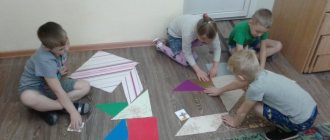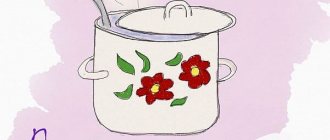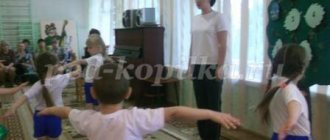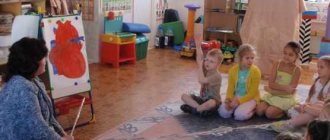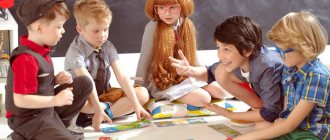Game “Caterpillars - Helpers” (TRIZ)
Game “Caterpillars - Helpers” (TRIZ)
Target:
formation of the concept of the significance of analyzers.
Tasks:
- to develop in children the ability to independently examine an object to find out the meanings of certain features. To promote the child’s conscious attitude towards perceptive action as the basis of sensory knowledge of the world;
- give the concept that a person has a brain that receives information from “helpers” (analyzers).
Game description
Children, look who is in my envelope: caterpillars are helpers. What is depicted on them (eye, hand, nose, tongue, ears). Take one caterpillar at a time, tell who got which helper - the caterpillar went to them. Children choose a caterpillar and answer
(I have eyes, eyes look, and my smart head sees and understands the signs of an object;
hands touch, and the head understands the signs of objects;
the ears listen, and the head “hears” and understands the signs of sounds;
the tongue tastes, and the head understands the meaning of the “taste” attribute of objects;
the nose smells, and the head understands the meaning of the “smell” attribute of objects).
Now take for your caterpillar helpers signs with the names of the features (temperature, smell, taste, color, sound) and explain why this particular sign of the name of the feature was chosen (I chose sound because the helpers are ears, etc.)
Now we will be researchers, and the assistants will help.
Boxes are prepared in advance - surprises for studying objects using all five analyzers. On the lid of the box there are signs with the names of the characteristics.
First
objects with the name of the attribute
“taste
” are placed - containers with pieces of chocolate, carrots, orange, garlic, lemon, napkins and individual forks. Children eat a product with their eyes closed, guess it and name what it tastes like (chocolate tastes sweet, etc.)
Which assistant helped? Did he complete the task?
In the second
- objects with the name of the sign “
smell”
(opaque jars with holes so that you can smell what is there (coffee, garlic, orange, cucumber, onion). Children smell and guess what is there.
Which assistant helped? Did he complete the task?
On the third
- objects with the name of the attribute
“sound”
(rattle - rattles, whistle - whistles, hammer - knocks, paper - rustles, bell - rings). Children try out what sounds objects can make and name them.
Which assistant helped? Did he complete the task?
On the fourth
- objects with the name of the attribute “
temperature” and “color
” (jars with different colored lids; hot, cold, ice water is poured into the jars). First, the feature name “color” is examined. Children name the color of the caps. Then the children are asked to examine the temperature of the jars and name which jars by temperature (a jar with a red lid is hot by temperature). This is how the contents of all surprise boxes are examined.
At the end of the game, children are given a set of cards with objects from which they assemble the remaining parts of their caterpillars. When the caterpillars are collected, the children explain their choice (my assistants are eyes, the attribute of the object is color, I chose the rainbow and colors, etc.)
Goals:
develop spatial imagination; systematize knowledge about the characteristics of objects; teach classification skills; develop imagination, the ability to transfer signs from one object to another; develop attention.
Equipment:
cards with pictures.
1. Game "Hide and Seek".
The lesson begins with a message from the teacher that the Toy is hidden somewhere and needs to be found. Simply going through different places will be long and uninteresting; it is better to ask targeted questions that lead to narrowing the search circle. You can draw an analogy by drawing a tree with large branches.
V.: Imagine that we need to find one leaf on this tree. You can, of course, sort through the leaves one by one until you find the one you need. Or you can do it in another way: find out where he is by asking questions. This leaf to the left of the trunk? Is this leaf taller than a large branch? That leaf to the right of the small branch?
etc.
(The teacher
After this, it is proposed to find the Toy based on questions that involve dividing the space into parts. It is advisable that it be hidden in some closet. Then you can ask additional questions: On which shelf and on which side is it
located?
2. Feature extraction.
The teacher puts 6-7 cards with pictures from different thematic groups on the table. Then he indicates the property, and children must name the characteristics of these objects.
For example, cards are given: crocodile, daisy, knife, boat, cloud, ball. The teacher calls the property “color”, the children indicate the characteristics in order: green, white with yellow, gray, brown, white, multi-colored; the teacher calls the property “size”, children - big, small, small, big, big, small; The teacher calls the property “weight”, the children call it heavy, light, light, heavy, light, light, etc.
Examples of properties: shape, substance, smell, “edibility”, smoothness, temperature, etc.
In this case, it is immediately necessary to show that there are signs that can change: the ball can be both large and small; the boat can be blue, green, or red; both wooden and rubber, etc.
3. Game for switching attention “Color, weight, size.”
At the command “Color!” children raise their arms above their heads, connecting them like a roof (similar to a pencil), at the command “Weight!” -arms to the sides, showing the scales, on the command “Size!” - place one hand on the other (“ruler”).
The teacher names various properties and signs in random order (for example: color, red, weight, size, light, green, small, color...), children must respond to them correctly.
4. Change of signs.
The teacher invites the children to divide all the cards into two groups and explain their conclusion.
- Despite the fact that you can find many different signs of division, the main difference is that among the objects there are objects of animate and inanimate nature.
After this, the teacher leaves only “non-living” objects on the table. Then, for each object, 1-2 characteristics are selected that need to be changed and the consequences of such a change presented. For example: What would happen if the knives became very, very
sharp or very, very big, like a house? What would happen if the balls became very heavy (or very light)?
etc.
At the same time, the teacher emphasizes that the functions of these objects would also change, they would no longer be able to fulfill their role (a very heavy ball cannot be used for playing, but what can be done with it now?).
5. Practical work.
Draw a familiar object, changing some features.
All children can be offered the same object for drawing, having previously discussed what “usual” features the object has and what unusual features it may have.
For example, a watermelon is round, striped, and grows on the ground. You can draw a watermelon of a different shape and color, growing on a tree or moving on its own, etc.
Exercise "Analogy"
The teacher invites the children to come up with various analogies: direct ones (What does this cloud look like? This leaf is like...?),
by characteristics
(The chicken is yellow, like...? The ball is light, like...?),
by functions
(The ball jumps, like...? The girl sings, like...?).
